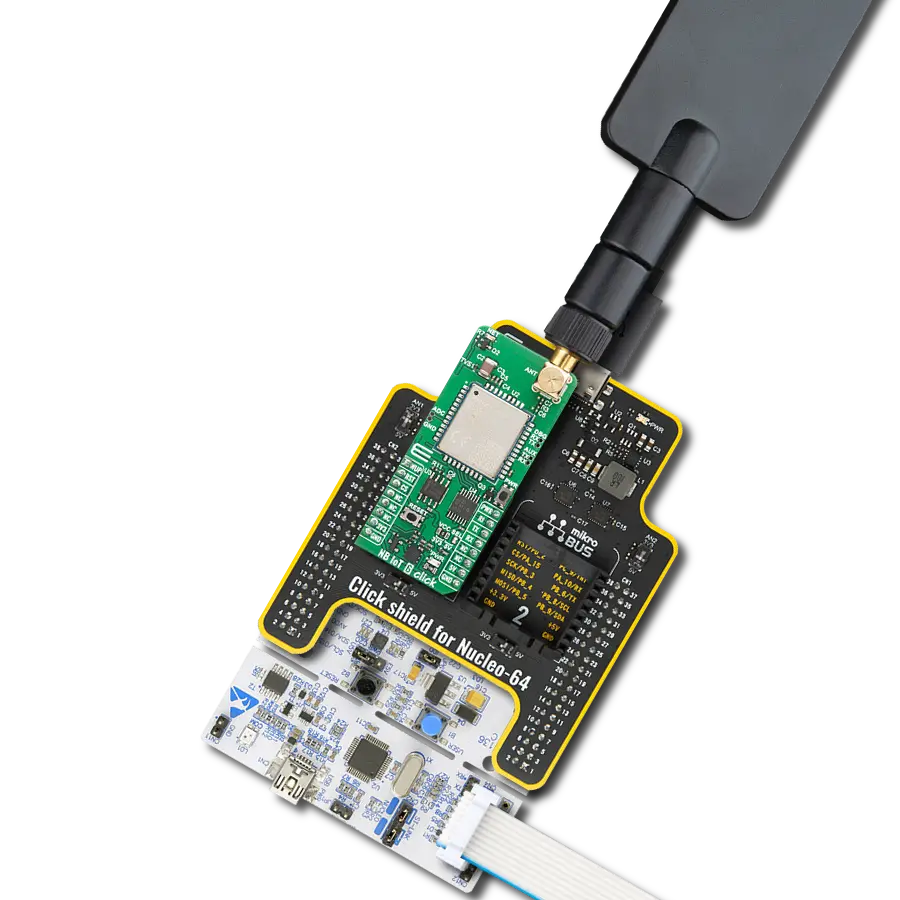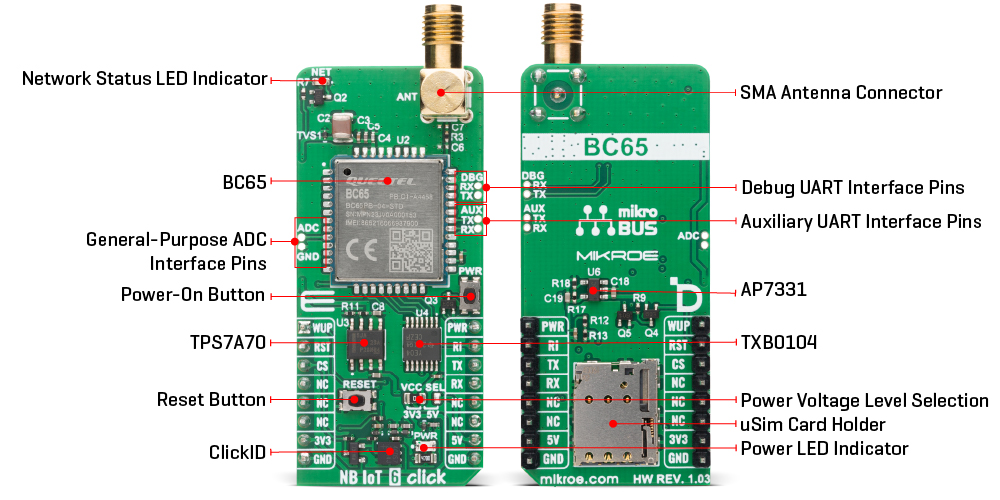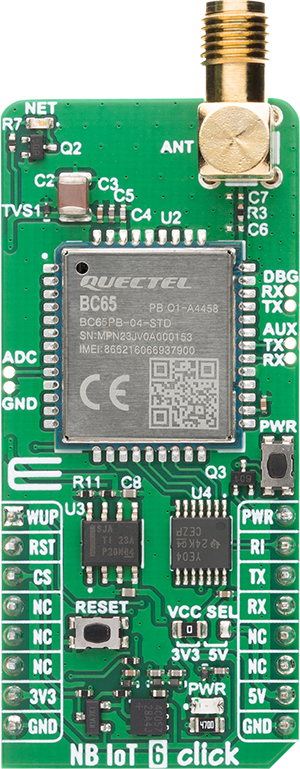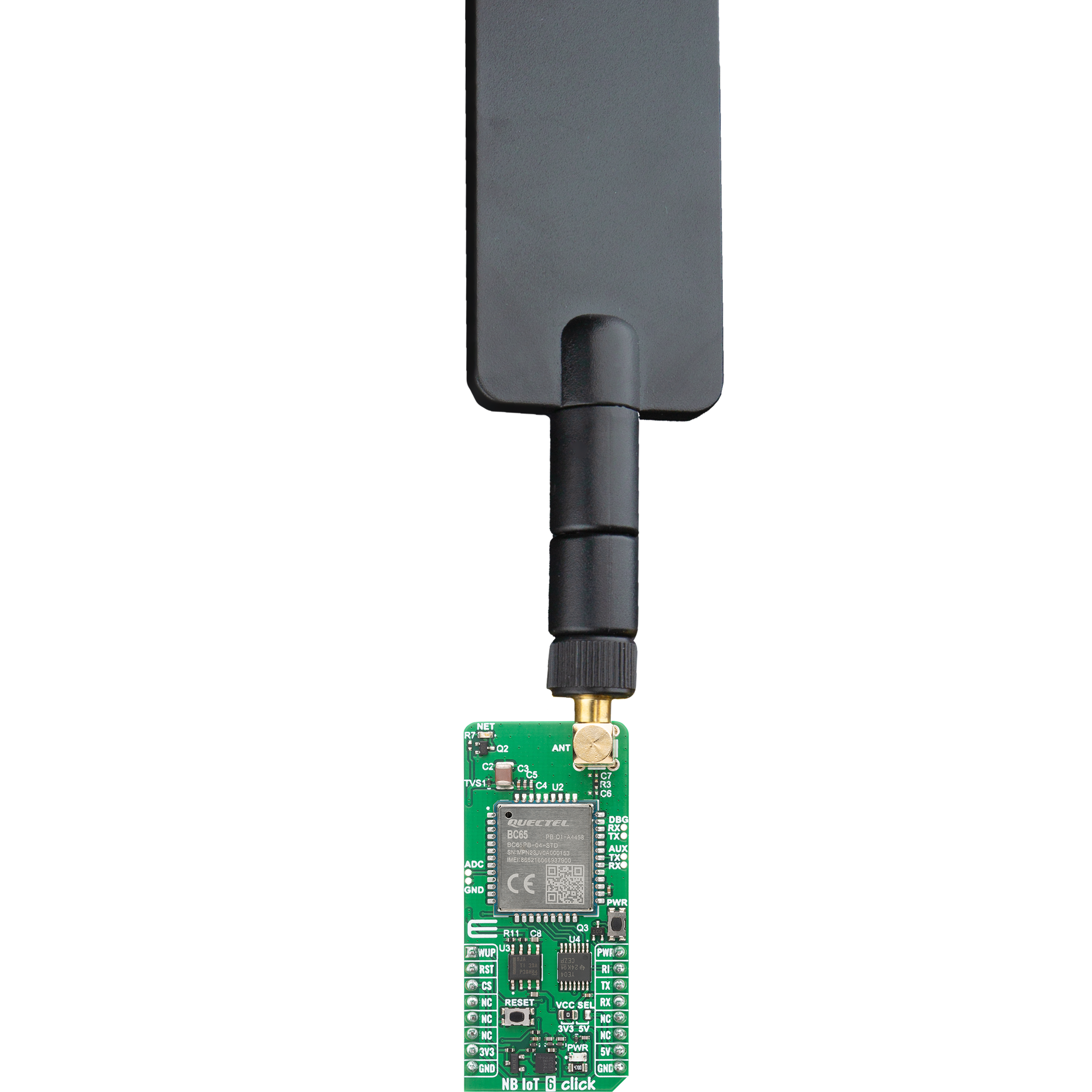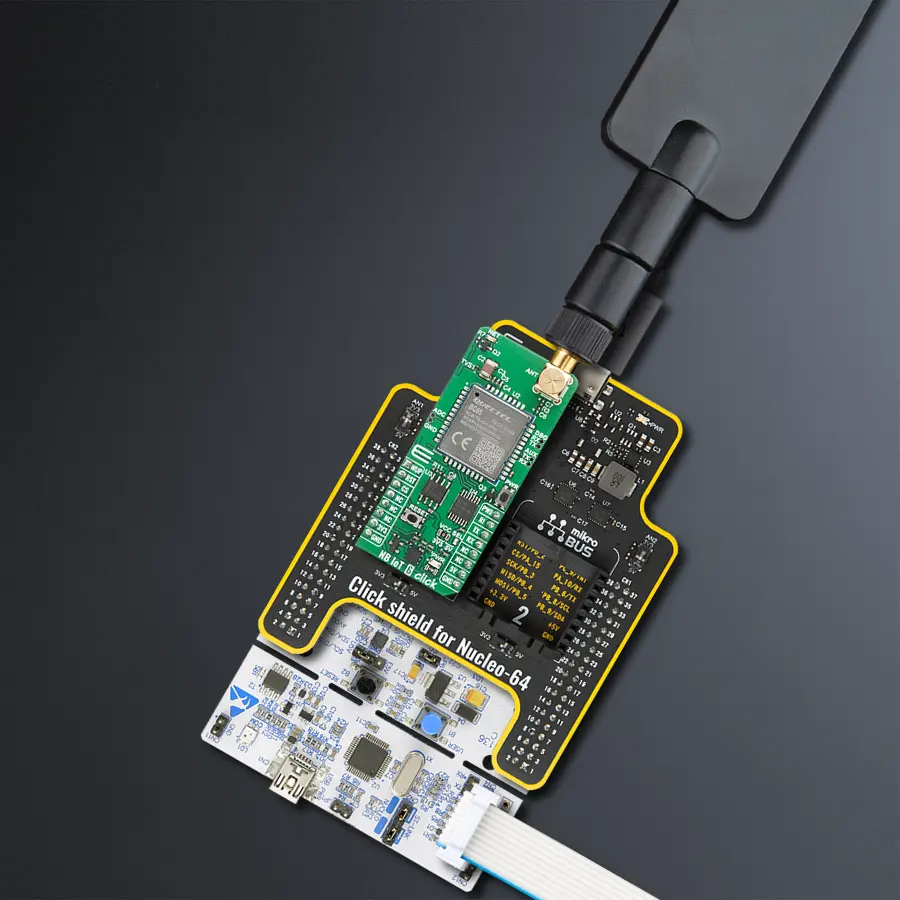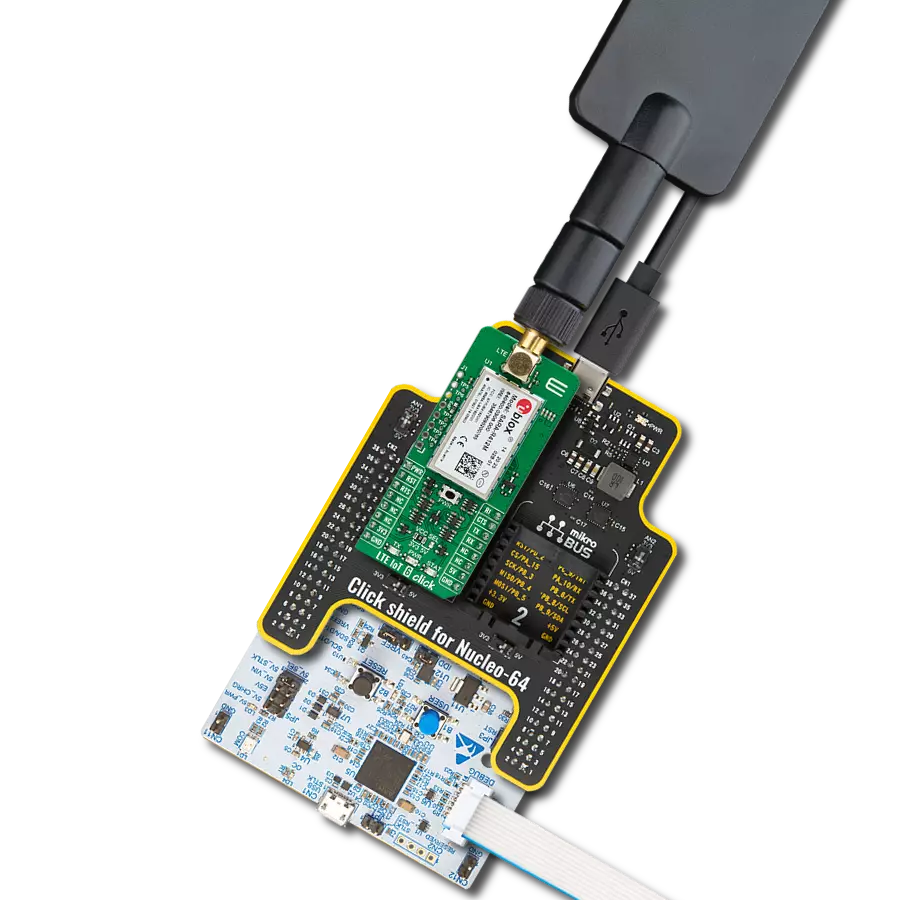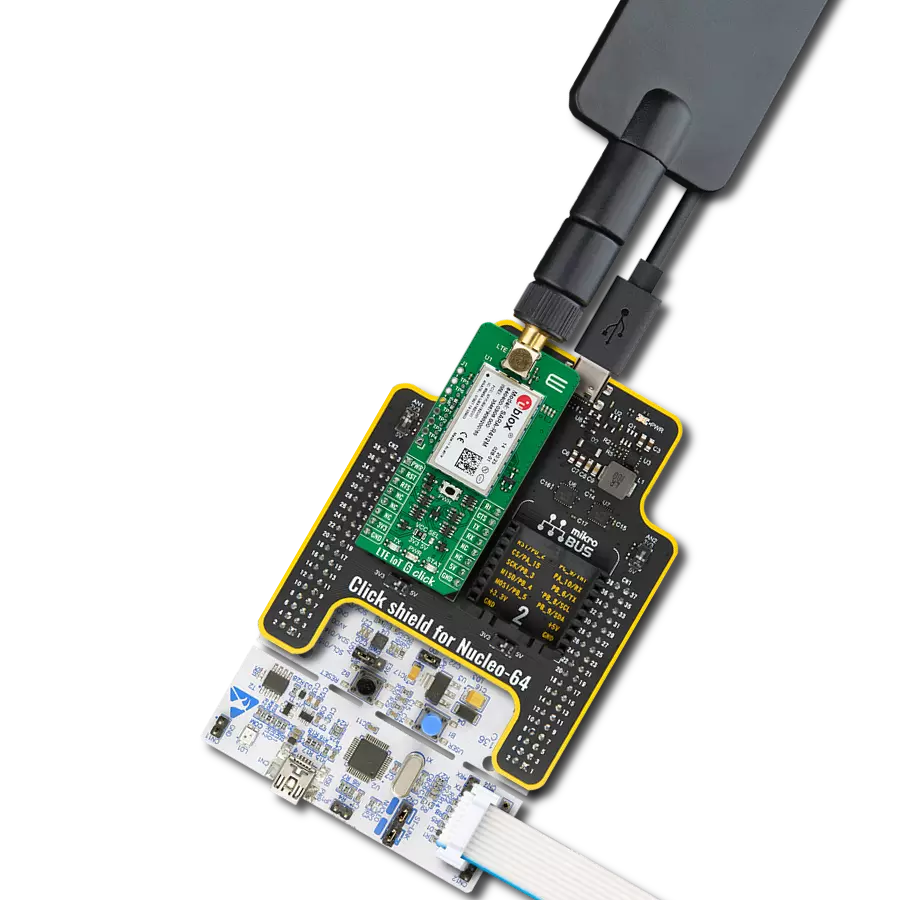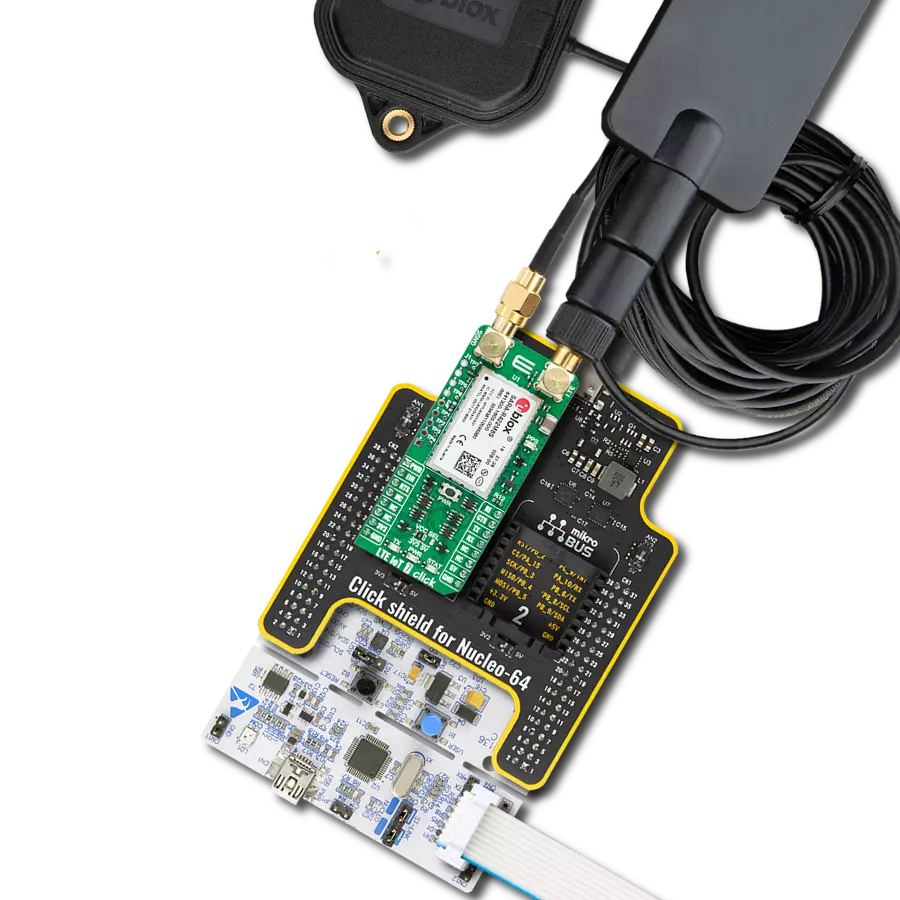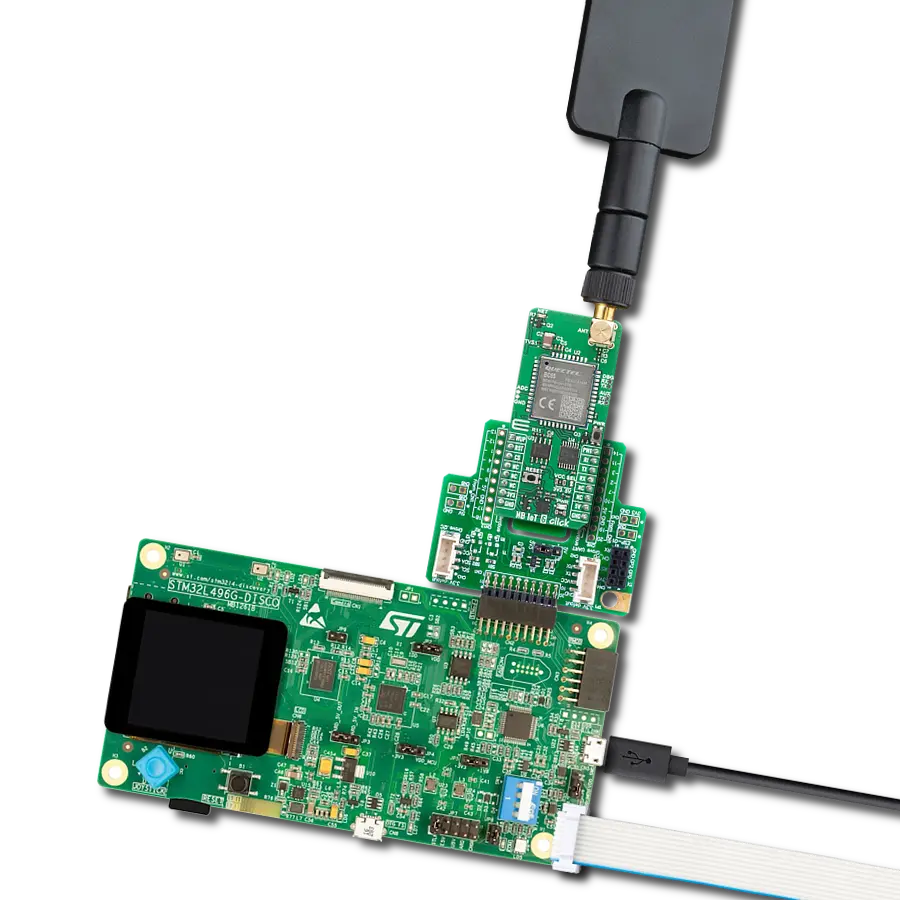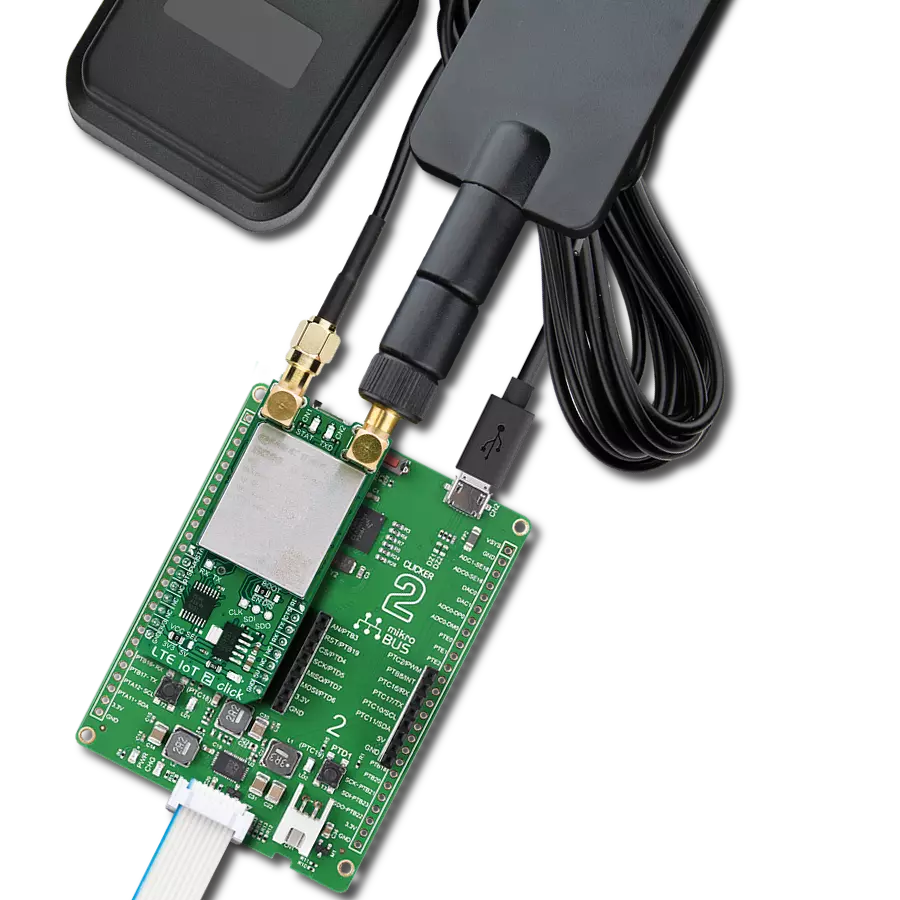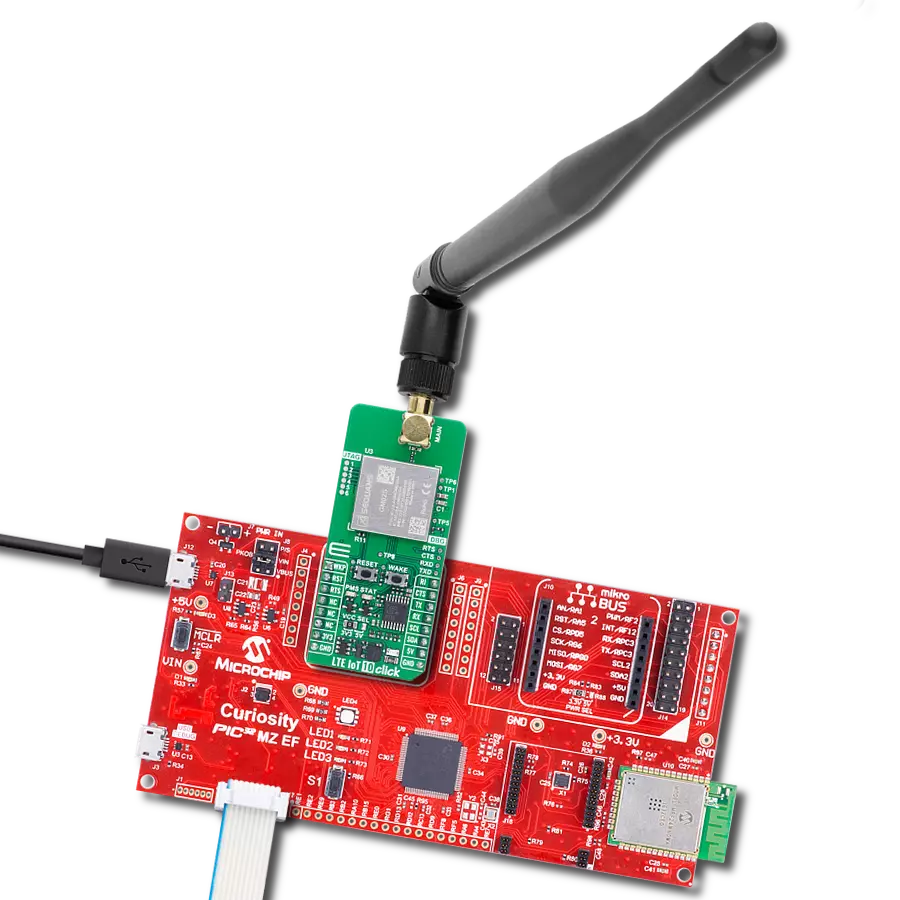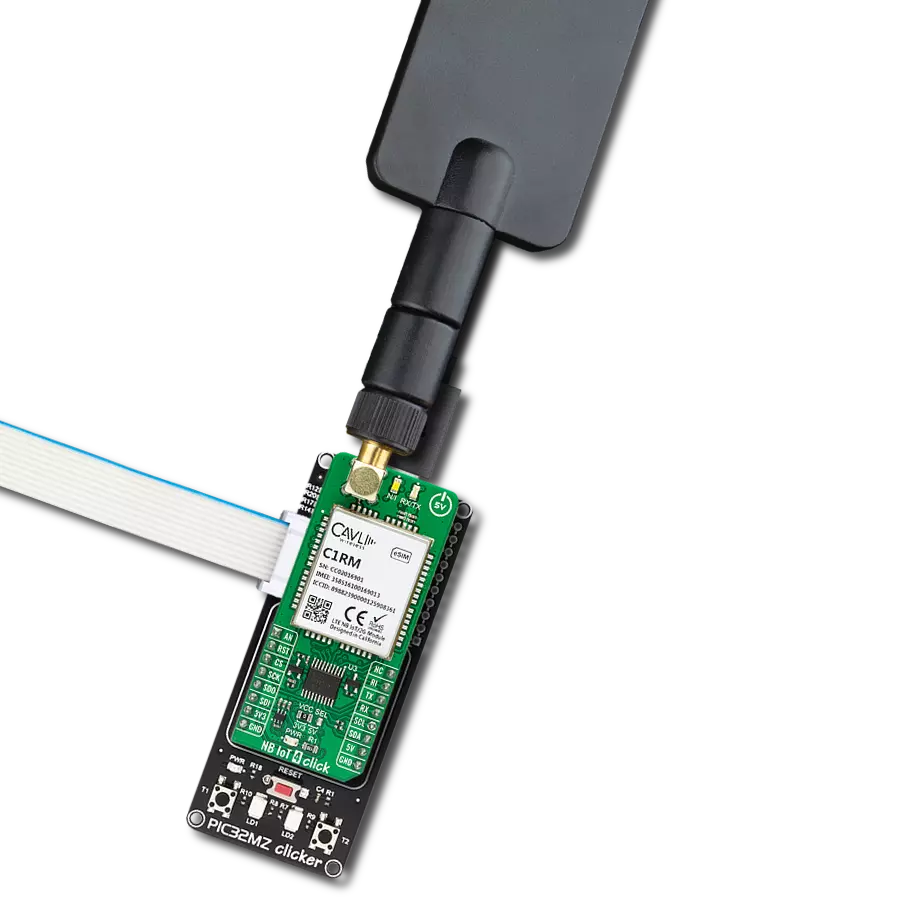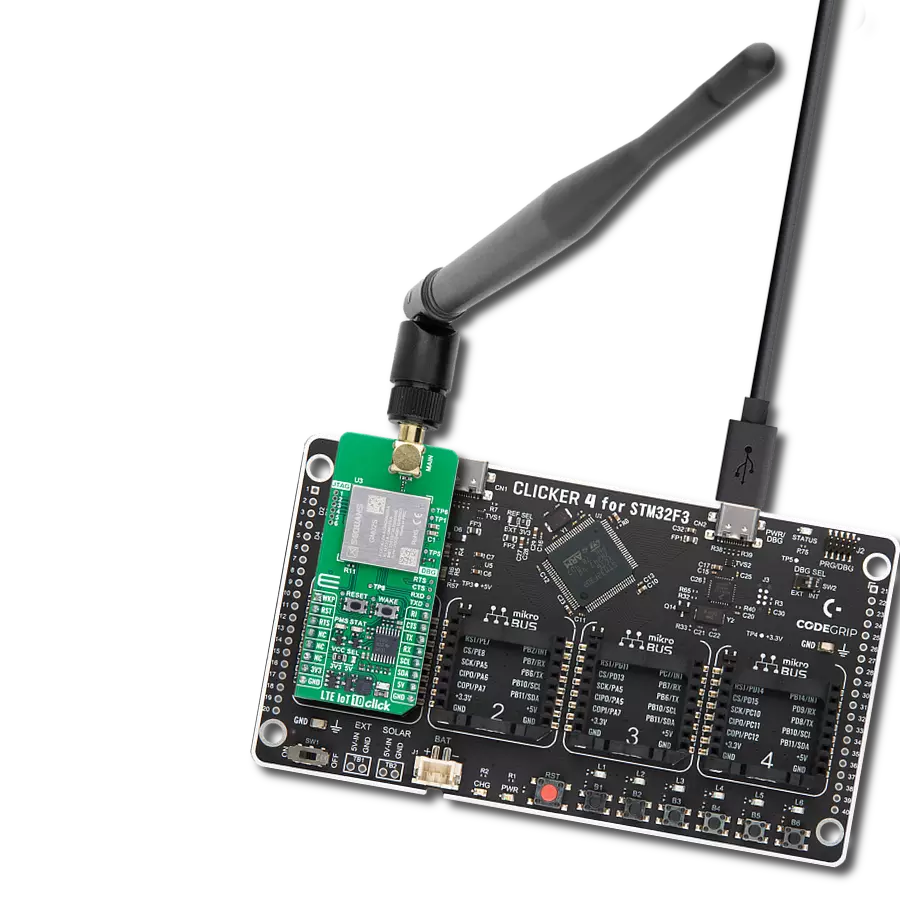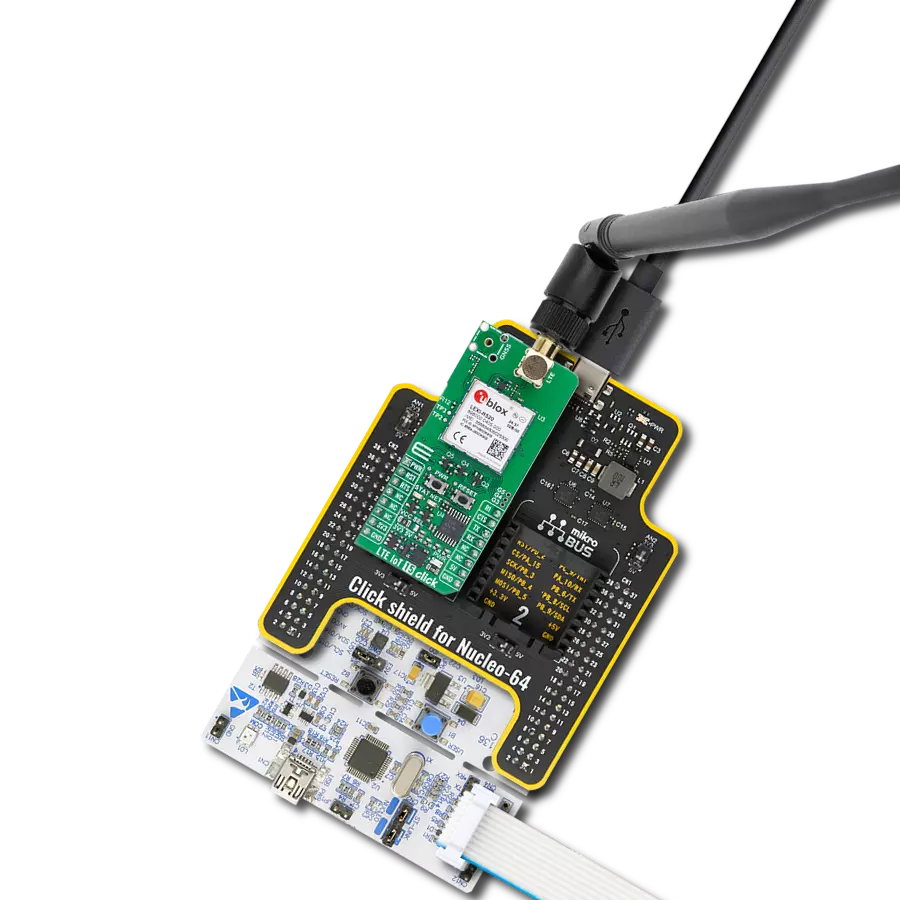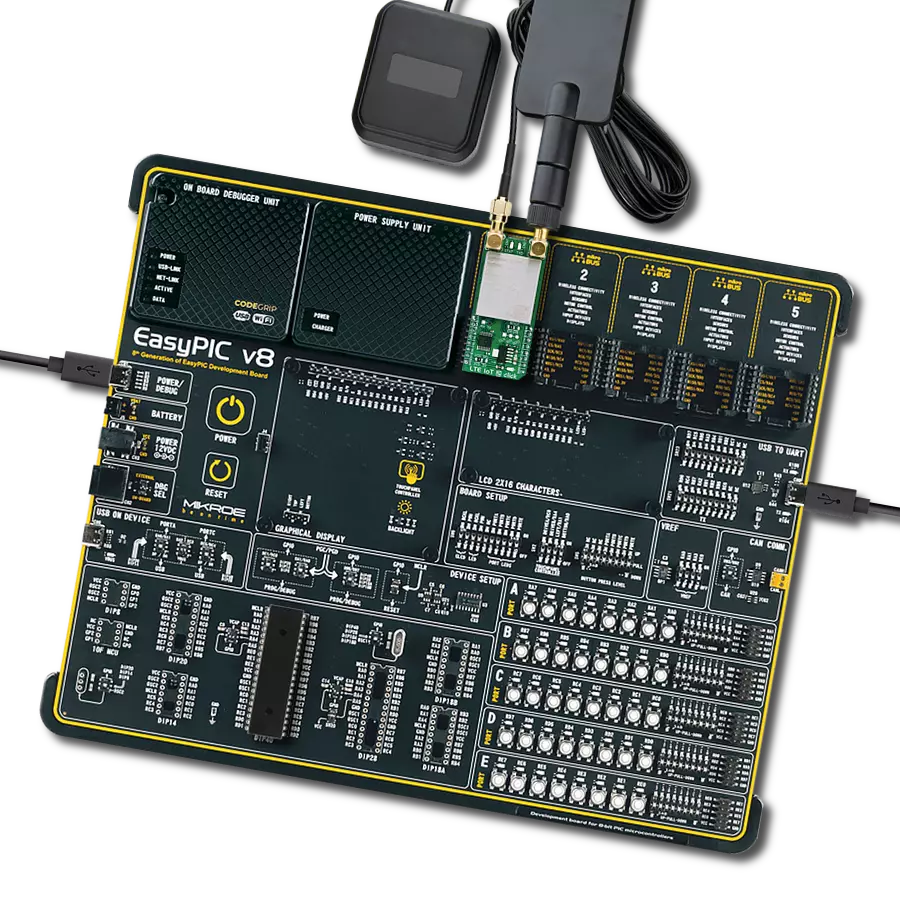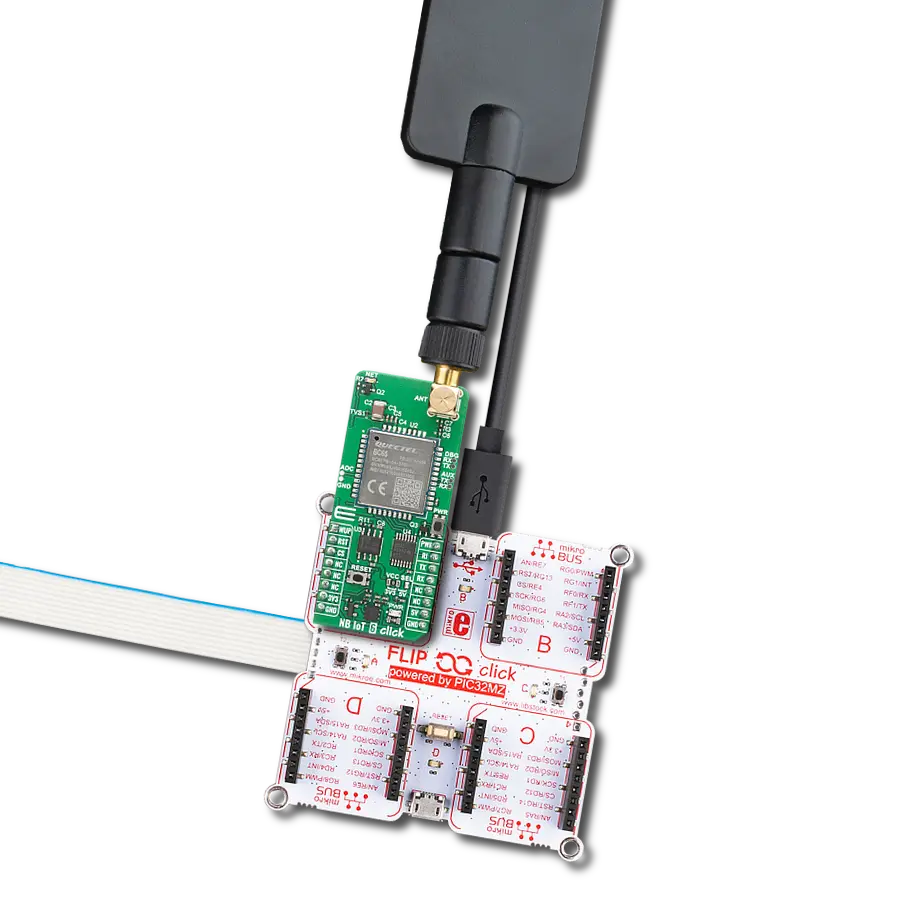Add ultra low-power cellular connectivity to smart city, agriculture, and industrial monitoring systems
A
A
Hardware Overview
How does it work?
NB IoT 6 Click is based on the BC65, a high-performance multi-band NB-IoT module from Quectel with ultra-low power consumption, designed in compliance with 3GPP Release 13 and Release 14 standards. Operating in a wide frequency range from approximately 700MHz up to 2.2GHz, the BC65 supports multiple LTE bands including B1, B3, B5, B8, B20, and B28, protocol stacks like UDP, TCP, and MQTT, along with a transmission power of 23dBm ±2dB and excellent receiving sensitivity of -114dBm without retransmission. This board brings reliable Narrowband IoT connectivity to embedded applications, such as smart metering, asset tracking, smart parking, wearables, smart city solutions, agriculture, environmental monitoring, and home appliances that requires wide-area coverage and stable communication. Communication between the BC65 and the host MCU is made through a UART interface, using standard UART RX and TX pins and Ring Indicator for data transfer. The module defaults to a communication speed of 115200bps, allowing for data exchange over AT commands. The board also includes several additional functionalities that
enhance its usability and control. The PWR button allows users to easily power the module ON or OFF, while the RESET button provides a quick way to reset the module. These functions can also be controlled digitally via the mikroBUS™ pins PWR and RST, offering greater flexibility. NB IoT 6 Click also integrates a rich set of additional communication and peripheral interfaces alongside the main UART connection, making it highly adaptable for diverse development scenarios. In addition to the primary UART interface used for standard data communication, the board provides dedicated pins for a debug UART (DBG), which is intended for firmware debugging and upgrading. It further includes an auxiliary UART (AUX) that allows flexible use of AT command communication and data transmission, giving developers extended control and connectivity options within their applications. Moreover, the module features one general-purpose 10-bit ADC channel that supports input signal levels from 0 to 1.8V, enabling straightforward analog signal acquisition for monitoring external sensors or other analog sources. The board features one SMA connector for the LTE antenna that MIKROE offers, like the LTE
Flat Rotation Antenna, and one blue NET LED that indicates the current network status of the module. The device has successfully registered on the network when the LED blinks slowly. A fast blinking pattern signals data transmission. When the LED is completely OFF, it indicates that the device is either powered OFF or in Power Saving Mode (PSM). The board also has a micro SIM card holder that supports both 1.8V and 3.0V uSIM cards, allowing users to select the most appropriate service provider for their particular use case. This Click board™ can operate with both 3.3V and 5V logic voltage levels selected via the VCC SEL jumper. Since the BC65 module operates at 4.07V and communicates at 1.8V, a logic-level translator, the TXB0104 is also used for proper operation and an accurate signal-level translation. This way, both 3.3V and 5V capable MCUs can use the communication lines properly. Also, this Click board™ comes equipped with a library containing easy-to-use functions and an example code that can be used as a reference for further development.
Features overview
Development board
Nucleo-64 with STM32F410RB MCU offers a cost-effective and adaptable platform for developers to explore new ideas and prototype their designs. This board harnesses the versatility of the STM32 microcontroller, enabling users to select the optimal balance of performance and power consumption for their projects. It accommodates the STM32 microcontroller in the LQFP64 package and includes essential components such as a user LED, which doubles as an ARDUINO® signal, alongside user and reset push-buttons, and a 32.768kHz crystal oscillator for precise timing operations. Designed with expansion and flexibility in mind, the Nucleo-64 board features an ARDUINO® Uno V3 expansion connector and ST morpho extension pin
headers, granting complete access to the STM32's I/Os for comprehensive project integration. Power supply options are adaptable, supporting ST-LINK USB VBUS or external power sources, ensuring adaptability in various development environments. The board also has an on-board ST-LINK debugger/programmer with USB re-enumeration capability, simplifying the programming and debugging process. Moreover, the board is designed to simplify advanced development with its external SMPS for efficient Vcore logic supply, support for USB Device full speed or USB SNK/UFP full speed, and built-in cryptographic features, enhancing both the power efficiency and security of projects. Additional connectivity is
provided through dedicated connectors for external SMPS experimentation, a USB connector for the ST-LINK, and a MIPI® debug connector, expanding the possibilities for hardware interfacing and experimentation. Developers will find extensive support through comprehensive free software libraries and examples, courtesy of the STM32Cube MCU Package. This, combined with compatibility with a wide array of Integrated Development Environments (IDEs), including IAR Embedded Workbench®, MDK-ARM, and STM32CubeIDE, ensures a smooth and efficient development experience, allowing users to fully leverage the capabilities of the Nucleo-64 board in their projects.
Microcontroller Overview
MCU Card / MCU
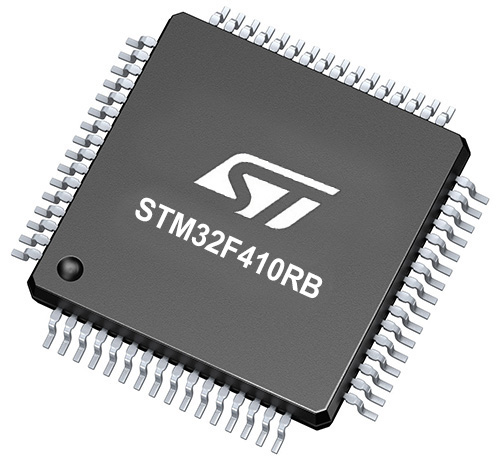
Architecture
ARM Cortex-M4
MCU Memory (KB)
128
Silicon Vendor
STMicroelectronics
Pin count
64
RAM (Bytes)
32768
You complete me!
Accessories
Click Shield for Nucleo-64 comes equipped with two proprietary mikroBUS™ sockets, allowing all the Click board™ devices to be interfaced with the STM32 Nucleo-64 board with no effort. This way, Mikroe allows its users to add any functionality from our ever-growing range of Click boards™, such as WiFi, GSM, GPS, Bluetooth, ZigBee, environmental sensors, LEDs, speech recognition, motor control, movement sensors, and many more. More than 1537 Click boards™, which can be stacked and integrated, are at your disposal. The STM32 Nucleo-64 boards are based on the microcontrollers in 64-pin packages, a 32-bit MCU with an ARM Cortex M4 processor operating at 84MHz, 512Kb Flash, and 96KB SRAM, divided into two regions where the top section represents the ST-Link/V2 debugger and programmer while the bottom section of the board is an actual development board. These boards are controlled and powered conveniently through a USB connection to program and efficiently debug the Nucleo-64 board out of the box, with an additional USB cable connected to the USB mini port on the board. Most of the STM32 microcontroller pins are brought to the IO pins on the left and right edge of the board, which are then connected to two existing mikroBUS™ sockets. This Click Shield also has several switches that perform functions such as selecting the logic levels of analog signals on mikroBUS™ sockets and selecting logic voltage levels of the mikroBUS™ sockets themselves. Besides, the user is offered the possibility of using any Click board™ with the help of existing bidirectional level-shifting voltage translators, regardless of whether the Click board™ operates at a 3.3V or 5V logic voltage level. Once you connect the STM32 Nucleo-64 board with our Click Shield for Nucleo-64, you can access hundreds of Click boards™, working with 3.3V or 5V logic voltage levels.
Used MCU Pins
mikroBUS™ mapper
Take a closer look
Click board™ Schematic
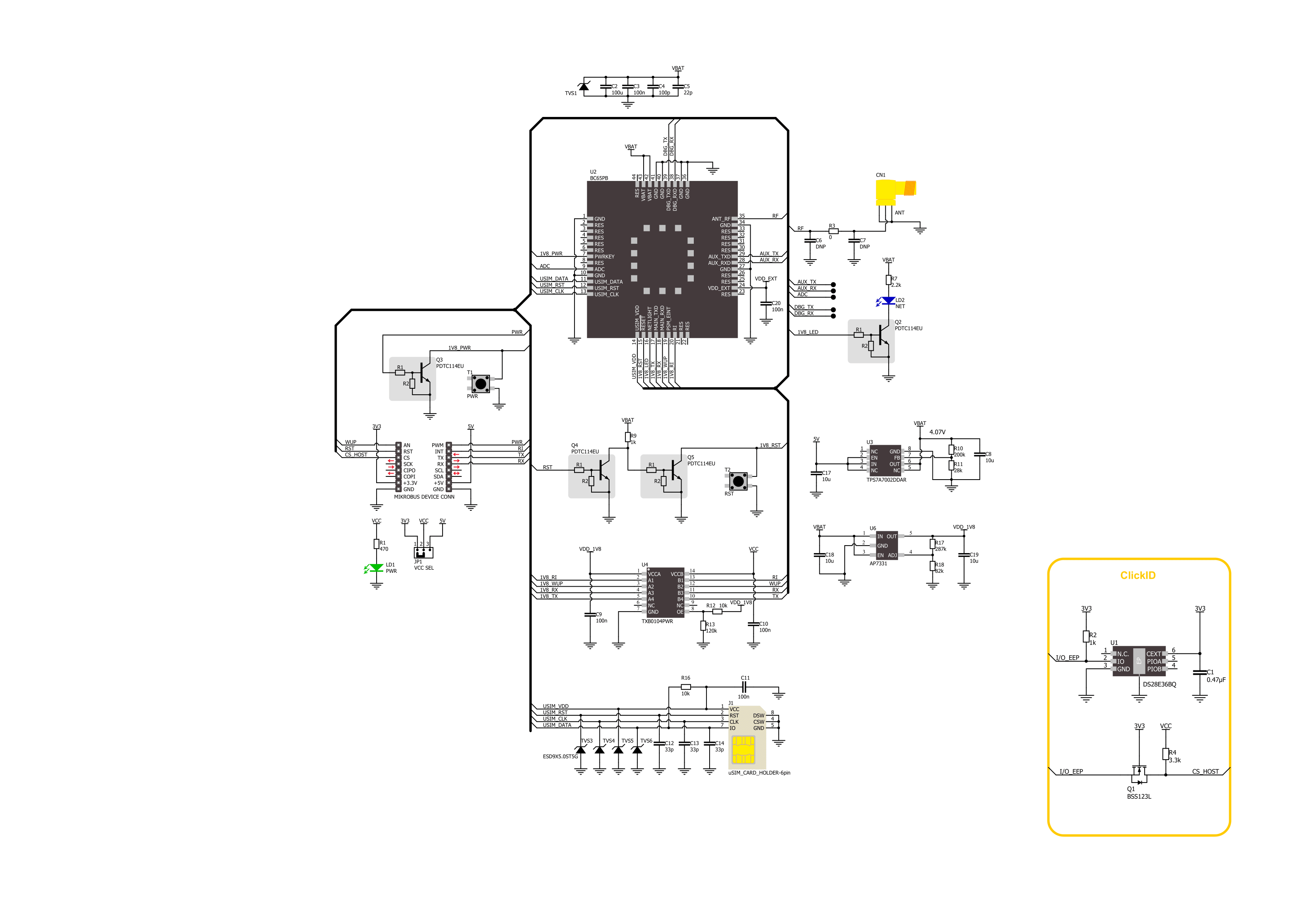
Step by step
Project assembly
Software Support
Library Description
NB IoT 6 Click demo application is developed using the NECTO Studio, ensuring compatibility with mikroSDK's open-source libraries and tools. Designed for plug-and-play implementation and testing, the demo is fully compatible with all development, starter, and mikromedia boards featuring a mikroBUS™ socket.
Example Description
Application example shows device capability of connecting to the network and sending SMS or TCP/UDP messages using standard "AT" commands.
Key functions:
nbiot6_cfg_setup- This function initializes Click configuration structure to initial values.nbiot6_init- This function initializes all necessary pins and peripherals used for this Click board.nbiot6_set_power_state- This function sets a desired power state by toggling PWR, RST, and WUP pins with a specific time frame.nbiot6_cmd_run- This function sends a specified command to the Click module.nbiot6_cmd_set- This function sets a value to a specified command of the Click module.nbiot6_send_sms_text- This function sends text message to a phone number.
Application Init
Initializes the driver and logger.
Application Task
Application task is split in few stages:
NBIOT6_POWER_UP- Powers up the device and reads system information.NBIOT6_CONFIG_CONNECTION- Sets configuration to device to be able to connect to the network.NBIOT6_CHECK_CONNECTION- Waits for the network registration indicated via CEREG command and then checks the signal quality report.NBIOT6_CONFIG_EXAMPLE- Configures device for the selected example.NBIOT6_EXAMPLE- Depending on the selected demo example, it sends an SMS message (in PDU or TXT mode) or TCP/UDP message. By default, the TCP/UDP example is selected.
Open Source
Code example
The complete application code and a ready-to-use project are available through the NECTO Studio Package Manager for direct installation in the NECTO Studio. The application code can also be found on the MIKROE GitHub account.
/*!
* @file main.c
* @brief NB IoT 6 Click Example.
*
* # Description
* Application example shows device capability of connecting to the network and
* sending SMS or TCP/UDP messages using standard "AT" commands.
*
* The demo application is composed of two sections :
*
* ## Application Init
* Initializes the driver and logger.
*
* ## Application Task
* Application task is split in few stages:
* - NBIOT6_POWER_UP:
* Powers up the device and reads system information.
*
* - NBIOT6_CONFIG_CONNECTION:
* Sets configuration to device to be able to connect to the network.
*
* - NBIOT6_CHECK_CONNECTION:
* Waits for the network registration indicated via CEREG command and then checks the signal quality report.
*
* - NBIOT6_CONFIG_EXAMPLE:
* Configures device for the selected example.
*
* - NBIOT6_EXAMPLE:
* Depending on the selected demo example, it sends an SMS message (in PDU or TXT mode) or TCP/UDP message.
*
* By default, the TCP/UDP example is selected.
*
* ## Additional Function
* - static void nbiot6_clear_app_buf ( void )
* - static void nbiot6_log_app_buf ( void )
* - static err_t nbiot6_process ( nbiot6_t *ctx )
* - static err_t nbiot6_read_response ( nbiot6_t *ctx, uint8_t *rsp, uint32_t max_rsp_time )
* - static err_t nbiot6_power_up ( nbiot6_t *ctx )
* - static err_t nbiot6_config_connection ( nbiot6_t *ctx )
* - static err_t nbiot6_check_connection ( nbiot6_t *ctx )
* - static err_t nbiot6_config_example ( nbiot6_t *ctx )
* - static err_t nbiot6_example ( nbiot6_t *ctx )
*
* @note
* In order for the examples to work, user needs to set the APN and SMSC (SMS PDU mode only)
* of entered SIM card as well as the phone number (SMS mode only) to which he wants to send an SMS.
* Enter valid values for the following macros: SIM_APN, SIM_SMSC and PHONE_NUMBER.
* Example:
SIM_APN "internet"
SIM_SMSC "+381610401"
PHONE_NUMBER "+381659999999"
*
* @author Stefan Filipovic
*
*/
#include "board.h"
#include "log.h"
#include "nbiot6.h"
#include "conversions.h"
// Example selection macros
#define EXAMPLE_TCP_UDP 0 // Example of sending messages to a TCP/UDP echo server
#define EXAMPLE_SMS 1 // Example of sending SMS to a phone number
#define DEMO_EXAMPLE EXAMPLE_TCP_UDP // Example selection macro
// SIM APN config
#define SIM_APN "" // Set valid SIM APN
// SMS example parameters
#define SIM_SMSC "" // Set valid SMS Service Center Address - only in SMS PDU mode
#define PHONE_NUMBER "" // Set Phone number to message
#define SMS_MODE "1" // SMS mode: "0" - PDU, "1" - TXT
// TCP/UDP example parameters
#define REMOTE_IP "54.187.244.144"// TCP/UDP echo server IP address
#define REMOTE_PORT "51111" // TCP/UDP echo server port
// Message content
#define MESSAGE_CONTENT "NB IoT 6 Click board - demo example."
// Application buffer size
#define APP_BUFFER_SIZE 256
#define PROCESS_BUFFER_SIZE 256
/**
* @brief Example states.
* @details Predefined enum values for application example state.
*/
typedef enum
{
NBIOT6_POWER_UP = 1,
NBIOT6_CONFIG_CONNECTION,
NBIOT6_CHECK_CONNECTION,
NBIOT6_CONFIG_EXAMPLE,
NBIOT6_EXAMPLE
} nbiot6_app_state_t;
/**
* @brief Application example variables.
* @details Variables used in application example.
*/
static uint8_t app_buf[ APP_BUFFER_SIZE ] = { 0 };
static int32_t app_buf_len = 0;
static nbiot6_app_state_t app_state = NBIOT6_POWER_UP;
static nbiot6_t nbiot6;
static log_t logger;
/**
* @brief NB IoT 6 clearing application buffer.
* @details This function clears memory of application buffer and reset its length.
* @note None.
*/
static void nbiot6_clear_app_buf ( void );
/**
* @brief NB IoT 6 log application buffer.
* @details This function logs data from application buffer to USB UART.
* @note None.
*/
static void nbiot6_log_app_buf ( void );
/**
* @brief NB IoT 6 data reading function.
* @details This function reads data from device and concatenates data to application buffer.
* @param[in] ctx : Click context object.
* See #nbiot6_t object definition for detailed explanation.
* @return @li @c 0 - Read some data.
* @li @c -1 - Nothing is read.
* See #err_t definition for detailed explanation.
* @note None.
*/
static err_t nbiot6_process ( nbiot6_t *ctx );
/**
* @brief NB IoT 6 read response function.
* @details This function waits for a response message, reads and displays it on the USB UART.
* @param[in] ctx : Click context object.
* See #nbiot6_t object definition for detailed explanation.
* @param[in] rsp : Expected response.
* @param[in] max_rsp_time : Maximum response time in milliseconds.
* @return @li @c 0 - OK response.
* @li @c -2 - Timeout error.
* @li @c -3 - Command error.
* See #err_t definition for detailed explanation.
* @note None.
*/
static err_t nbiot6_read_response ( nbiot6_t *ctx, uint8_t *rsp, uint32_t max_rsp_time );
/**
* @brief NB IoT 6 power up function.
* @details This function powers up the device and reads system information.
* @param[in] ctx : Click context object.
* See #nbiot6_t object definition for detailed explanation.
* @return @li @c 0 - OK.
* @li @c != 0 - Read response error.
* See #err_t definition for detailed explanation.
* @note None.
*/
static err_t nbiot6_power_up ( nbiot6_t *ctx );
/**
* @brief NB IoT 6 config connection function.
* @details This function configures and enables connection to the specified network.
* @param[in] ctx : Click context object.
* See #nbiot6_t object definition for detailed explanation.
* @return @li @c 0 - OK.
* @li @c != 0 - Read response error.
* See #err_t definition for detailed explanation.
* @note None.
*/
static err_t nbiot6_config_connection ( nbiot6_t *ctx );
/**
* @brief NB IoT 6 check connection function.
* @details This function checks the connection to network.
* @param[in] ctx : Click context object.
* See #nbiot6_t object definition for detailed explanation.
* @return @li @c 0 - OK.
* @li @c != 0 - Read response error.
* See #err_t definition for detailed explanation.
* @note None.
*/
static err_t nbiot6_check_connection ( nbiot6_t *ctx );
/**
* @brief NB IoT 6 config example function.
* @details This function configures device for the selected example.
* @param[in] ctx : Click context object.
* See #nbiot6_t object definition for detailed explanation.
* @return @li @c 0 - OK.
* @li @c != 0 - Read response error.
* See #err_t definition for detailed explanation.
* @note None.
*/
static err_t nbiot6_config_example ( nbiot6_t *ctx );
/**
* @brief NB IoT 6 example function.
* @details This function executes SMS or TCP/UDP example depending on the DEMO_EXAMPLE macro.
* @param[in] ctx : Click context object.
* See #nbiot6_t object definition for detailed explanation.
* @return @li @c 0 - OK.
* @li @c != 0 - Read response error.
* See #err_t definition for detailed explanation.
* @note None.
*/
static err_t nbiot6_example ( nbiot6_t *ctx );
void application_init ( void )
{
log_cfg_t log_cfg; /**< Logger config object. */
nbiot6_cfg_t nbiot6_cfg; /**< Click config object. */
/**
* Logger initialization.
* Default baud rate: 115200
* Default log level: LOG_LEVEL_DEBUG
* @note If USB_UART_RX and USB_UART_TX
* are defined as HAL_PIN_NC, you will
* need to define them manually for log to work.
* See @b LOG_MAP_USB_UART macro definition for detailed explanation.
*/
LOG_MAP_USB_UART( log_cfg );
log_init( &logger, &log_cfg );
log_info( &logger, " Application Init " );
// Click initialization.
nbiot6_cfg_setup( &nbiot6_cfg );
NBIOT6_MAP_MIKROBUS( nbiot6_cfg, MIKROBUS_1 );
if ( UART_ERROR == nbiot6_init( &nbiot6, &nbiot6_cfg ) )
{
log_error( &logger, " Communication init." );
for ( ; ; );
}
log_info( &logger, " Application Task " );
app_state = NBIOT6_POWER_UP;
log_printf( &logger, ">>> APP STATE - POWER UP <<<\r\n\n" );
}
void application_task ( void )
{
switch ( app_state )
{
case NBIOT6_POWER_UP:
{
if ( NBIOT6_OK == nbiot6_power_up( &nbiot6 ) )
{
app_state = NBIOT6_CONFIG_CONNECTION;
log_printf( &logger, ">>> APP STATE - CONFIG CONNECTION <<<\r\n\n" );
}
break;
}
case NBIOT6_CONFIG_CONNECTION:
{
if ( NBIOT6_OK == nbiot6_config_connection( &nbiot6 ) )
{
app_state = NBIOT6_CHECK_CONNECTION;
log_printf( &logger, ">>> APP STATE - CHECK CONNECTION <<<\r\n\n" );
}
break;
}
case NBIOT6_CHECK_CONNECTION:
{
if ( NBIOT6_OK == nbiot6_check_connection( &nbiot6 ) )
{
app_state = NBIOT6_CONFIG_EXAMPLE;
log_printf( &logger, ">>> APP STATE - CONFIG EXAMPLE <<<\r\n\n" );
}
break;
}
case NBIOT6_CONFIG_EXAMPLE:
{
if ( NBIOT6_OK == nbiot6_config_example( &nbiot6 ) )
{
app_state = NBIOT6_EXAMPLE;
log_printf( &logger, ">>> APP STATE - EXAMPLE <<<\r\n\n" );
}
break;
}
case NBIOT6_EXAMPLE:
{
nbiot6_example( &nbiot6 );
break;
}
default:
{
log_error( &logger, " APP STATE." );
break;
}
}
}
int main ( void )
{
/* Do not remove this line or clock might not be set correctly. */
#ifdef PREINIT_SUPPORTED
preinit();
#endif
application_init( );
for ( ; ; )
{
application_task( );
}
return 0;
}
static void nbiot6_clear_app_buf ( void )
{
memset( app_buf, 0, app_buf_len );
app_buf_len = 0;
}
static void nbiot6_log_app_buf ( void )
{
for ( int32_t buf_cnt = 0; buf_cnt < app_buf_len; buf_cnt++ )
{
log_printf( &logger, "%c", app_buf[ buf_cnt ] );
}
}
static err_t nbiot6_process ( nbiot6_t *ctx )
{
uint8_t rx_buf[ PROCESS_BUFFER_SIZE ] = { 0 };
int32_t overflow_bytes = 0;
int32_t rx_cnt = 0;
int32_t rx_size = nbiot6_generic_read( ctx, rx_buf, PROCESS_BUFFER_SIZE );
if ( ( rx_size > 0 ) && ( rx_size <= APP_BUFFER_SIZE ) )
{
if ( ( app_buf_len + rx_size ) > APP_BUFFER_SIZE )
{
overflow_bytes = ( app_buf_len + rx_size ) - APP_BUFFER_SIZE;
app_buf_len = APP_BUFFER_SIZE - rx_size;
memmove ( app_buf, &app_buf[ overflow_bytes ], app_buf_len );
memset ( &app_buf[ app_buf_len ], 0, overflow_bytes );
}
for ( rx_cnt = 0; rx_cnt < rx_size; rx_cnt++ )
{
if ( rx_buf[ rx_cnt ] )
{
app_buf[ app_buf_len++ ] = rx_buf[ rx_cnt ];
}
}
return NBIOT6_OK;
}
return NBIOT6_ERROR;
}
static err_t nbiot6_read_response ( nbiot6_t *ctx, uint8_t *rsp, uint32_t max_rsp_time )
{
uint32_t timeout_cnt = 0;
nbiot6_clear_app_buf( );
nbiot6_process( ctx );
while ( ( 0 == strstr( app_buf, rsp ) ) &&
( 0 == strstr( app_buf, NBIOT6_RSP_ERROR ) ) )
{
nbiot6_process( ctx );
if ( timeout_cnt++ > max_rsp_time )
{
nbiot6_log_app_buf( );
nbiot6_clear_app_buf( );
log_error( &logger, " Timeout!" );
return NBIOT6_ERROR_TIMEOUT;
}
Delay_ms( 1 );
}
Delay_ms ( 200 );
nbiot6_process( ctx );
nbiot6_log_app_buf( );
if ( strstr( app_buf, rsp ) )
{
log_printf( &logger, "--------------------------------\r\n" );
return NBIOT6_OK;
}
return NBIOT6_ERROR_CMD;
}
static err_t nbiot6_power_up ( nbiot6_t *ctx )
{
err_t error_flag = NBIOT6_OK;
log_printf( &logger, ">>> Power up device.\r\n" );
nbiot6_set_power_state ( ctx, NBIOT6_POWER_STATE_ON );
log_printf( &logger, ">>> Perform device hardware reset.\r\n" );
nbiot6_set_power_state ( ctx, NBIOT6_POWER_STATE_RESET );
log_printf( &logger, ">>> Check communication.\r\n" );
nbiot6_clear_app_buf ( );
for ( ; ; )
{
// Wake up AT interface
nbiot6_set_power_state ( ctx, NBIOT6_POWER_STATE_WAKEUP );
nbiot6_cmd_run( ctx, NBIOT6_CMD_AT );
nbiot6_process( ctx );
if ( app_buf_len > 0 )
{
break;
}
}
nbiot6_cmd_run( ctx, NBIOT6_CMD_AT );
error_flag |= nbiot6_read_response( ctx, NBIOT6_RSP_OK, NBIOT6_MAX_RSP_TIME_DEFAULT );
log_printf( &logger, ">>> Get device model ID.\r\n" );
nbiot6_cmd_run( ctx, NBIOT6_CMD_GET_MODEL_ID );
error_flag |= nbiot6_read_response( ctx, NBIOT6_RSP_OK, NBIOT6_MAX_RSP_TIME_DEFAULT );
log_printf( &logger, ">>> Get manufacturer revision number.\r\n" );
nbiot6_cmd_run( ctx, NBIOT6_CMD_GET_MANUFACTURER_REVISION );
error_flag |= nbiot6_read_response( ctx, NBIOT6_RSP_OK, NBIOT6_MAX_RSP_TIME_DEFAULT );
log_printf( &logger, ">>> Get device serial number.\r\n" );
nbiot6_cmd_run( ctx, NBIOT6_CMD_GET_SERIAL_NUM );
error_flag |= nbiot6_read_response( ctx, NBIOT6_RSP_OK, NBIOT6_MAX_RSP_TIME_DEFAULT );
return error_flag;
}
static err_t nbiot6_config_connection ( nbiot6_t *ctx )
{
err_t error_flag = NBIOT6_OK;
#if ( ( DEMO_EXAMPLE == EXAMPLE_TCP_UDP ) || ( DEMO_EXAMPLE == EXAMPLE_SMS ) )
log_printf( &logger, ">>> Enable NETLIGHT indication.\r\n" );
#define NETLIGHT_ENABLE "1"
nbiot6_cmd_set( ctx, NBIOT6_CMD_CONFIG_NETLIGHT_LED, NETLIGHT_ENABLE );
error_flag |= nbiot6_read_response( ctx, NBIOT6_RSP_OK, NBIOT6_MAX_RSP_TIME_DEFAULT );
log_printf( &logger, ">>> Deregister from network.\r\n" );
#define DEREGISTER_FROM_NETWORK "2"
nbiot6_cmd_set( ctx, NBIOT6_CMD_OPERATOR_SELECTION, DEREGISTER_FROM_NETWORK );
error_flag |= nbiot6_read_response( ctx, NBIOT6_RSP_OK, NBIOT6_MAX_RSP_TIME_COPS );
log_printf( &logger, ">>> Set SIM APN.\r\n" );
nbiot6_set_sim_apn( &nbiot6, SIM_APN );
error_flag |= nbiot6_read_response( ctx, NBIOT6_RSP_OK, NBIOT6_MAX_RSP_TIME_DEFAULT );
log_printf( &logger, ">>> Enable full functionality.\r\n" );
#define FULL_FUNCTIONALITY "1"
nbiot6_cmd_set( ctx, NBIOT6_CMD_SET_UE_FUNCTIONALITY, FULL_FUNCTIONALITY );
error_flag |= nbiot6_read_response( ctx, NBIOT6_RSP_OK, NBIOT6_MAX_RSP_TIME_CFUN );
log_printf( &logger, ">>> Enable network registration.\r\n" );
#define ENABLE_REG "2"
nbiot6_cmd_set( ctx, NBIOT6_CMD_NETWORK_REGISTRATION, ENABLE_REG );
error_flag |= nbiot6_read_response( ctx, NBIOT6_RSP_OK, NBIOT6_MAX_RSP_TIME_DEFAULT );
log_printf( &logger, ">>> Set automatic registration.\r\n" );
#define AUTOMATIC_REGISTRATION "0"
nbiot6_cmd_set( ctx, NBIOT6_CMD_OPERATOR_SELECTION, AUTOMATIC_REGISTRATION );
error_flag |= nbiot6_read_response( ctx, NBIOT6_RSP_OK, NBIOT6_MAX_RSP_TIME_COPS );
#endif
return error_flag;
}
static err_t nbiot6_check_connection ( nbiot6_t *ctx )
{
err_t error_flag = NBIOT6_OK;
#if ( ( DEMO_EXAMPLE == EXAMPLE_TCP_UDP ) || ( DEMO_EXAMPLE == EXAMPLE_SMS ) )
log_printf( &logger, ">>> Check network registration.\r\n" );
nbiot6_cmd_get( &nbiot6, NBIOT6_CMD_NETWORK_REGISTRATION );
error_flag |= nbiot6_read_response( ctx, NBIOT6_RSP_OK, NBIOT6_MAX_RSP_TIME_DEFAULT );
if ( strstr( app_buf, NBIOT6_URC_NETWORK_REGISTERED ) )
{
Delay_ms ( 1000 );
log_printf( &logger, ">>> Check signal quality.\r\n" );
nbiot6_cmd_run( &nbiot6, NBIOT6_CMD_SIGNAL_QUALITY_REPORT );
error_flag |= nbiot6_read_response( ctx, NBIOT6_RSP_OK, NBIOT6_MAX_RSP_TIME_DEFAULT );
}
else
{
error_flag = NBIOT6_ERROR;
Delay_ms ( 1000 );
Delay_ms ( 1000 );
}
#endif
return error_flag;
}
static err_t nbiot6_config_example ( nbiot6_t *ctx )
{
err_t error_flag = NBIOT6_OK;
#if ( DEMO_EXAMPLE == EXAMPLE_TCP_UDP )
log_printf( &logger, ">>> Activate PDP context.\r\n" );
#define ACTIVATE_PDP_CONTEXT "1,1"
nbiot6_cmd_set( &nbiot6, NBIOT6_CMD_ACTIVATE_PDP_CONTEXT, ACTIVATE_PDP_CONTEXT );
error_flag |= nbiot6_read_response( ctx, NBIOT6_RSP_OK, NBIOT6_MAX_RSP_TIME_CGACT );
log_printf( &logger, ">>> Show PDP address.\r\n" );
#define PDP_CID "1"
nbiot6_cmd_set( &nbiot6, NBIOT6_CMD_SHOW_PDP_ADDRESS, PDP_CID );
error_flag |= nbiot6_read_response( ctx, NBIOT6_RSP_OK, NBIOT6_MAX_RSP_TIME_DEFAULT );
#elif ( DEMO_EXAMPLE == EXAMPLE_SMS )
log_printf( &logger, ">>> Select SMS format.\r\n" );
nbiot6_cmd_set( &nbiot6, NBIOT6_CMD_SELECT_SMS_FORMAT, SMS_MODE );
error_flag |= nbiot6_read_response( ctx, NBIOT6_RSP_OK, NBIOT6_MAX_RSP_TIME_DEFAULT );
#endif
return error_flag;
}
static err_t nbiot6_example ( nbiot6_t *ctx )
{
err_t error_flag = NBIOT6_OK;
#if ( DEMO_EXAMPLE == EXAMPLE_TCP_UDP )
uint8_t cmd_buf[ NBIOT6_TX_DRV_BUFFER_SIZE ] = { 0 };
// Get message length
uint8_t message_len_buf[ 10 ] = { 0 };
uint16_t message_len = strlen( MESSAGE_CONTENT );
uint16_to_str( message_len, message_len_buf );
l_trim( message_len_buf );
r_trim( message_len_buf );
log_printf( &logger, ">>> Open TCP connection.\r\n" );
#define PDP_CID "1"
#define TCP_SOCKET_NUM "0"
#define TCP_SERVICE_TYPE "TCP"
strcpy( cmd_buf, PDP_CID );
strcat( cmd_buf, "," );
strcat( cmd_buf, TCP_SOCKET_NUM );
strcat( cmd_buf, ",\"" );
strcat( cmd_buf, TCP_SERVICE_TYPE );
strcat( cmd_buf, "\",\"" );
strcat( cmd_buf, REMOTE_IP );
strcat( cmd_buf, "\"," );
strcat( cmd_buf, REMOTE_PORT );
nbiot6_cmd_set ( &nbiot6, NBIOT6_CMD_OPEN_SOCKET, cmd_buf );
error_flag |= nbiot6_read_response( ctx, NBIOT6_URC_OPEN_SOCKET, NBIOT6_MAX_RSP_TIME_URC );
log_printf( &logger, ">>> Open UDP connection.\r\n" );
#define UDP_SOCKET_NUM "1"
#define UDP_SERVICE_TYPE "UDP"
strcpy( cmd_buf, PDP_CID );
strcat( cmd_buf, "," );
strcat( cmd_buf, UDP_SOCKET_NUM );
strcat( cmd_buf, ",\"" );
strcat( cmd_buf, UDP_SERVICE_TYPE );
strcat( cmd_buf, "\",\"" );
strcat( cmd_buf, REMOTE_IP );
strcat( cmd_buf, "\"," );
strcat( cmd_buf, REMOTE_PORT );
nbiot6_cmd_set ( &nbiot6, NBIOT6_CMD_OPEN_SOCKET, cmd_buf );
error_flag |= nbiot6_read_response( ctx, NBIOT6_URC_OPEN_SOCKET, NBIOT6_MAX_RSP_TIME_URC );
log_printf( &logger, ">>> Write message to TCP connection.\r\n" );
strcpy( cmd_buf, TCP_SOCKET_NUM );
strcat( cmd_buf, "," );
strcat( cmd_buf, message_len_buf );
nbiot6_cmd_set ( &nbiot6, NBIOT6_CMD_SEND_TCP_IP_TEXT_DATA, cmd_buf );
Delay_ms ( 100 );
nbiot6_generic_write ( &nbiot6, MESSAGE_CONTENT, message_len );
error_flag |= nbiot6_read_response( ctx, NBIOT6_URC_RECEIVED_DATA, NBIOT6_MAX_RSP_TIME_URC );
log_printf( &logger, ">>> Read response from TCP connection.\r\n" );
nbiot6_cmd_set( &nbiot6, NBIOT6_CMD_RECEIVE_TCP_IP_DATA, cmd_buf );
error_flag |= nbiot6_read_response( ctx, NBIOT6_RSP_OK, NBIOT6_MAX_RSP_TIME_DEFAULT );
log_printf( &logger, ">>> Write message to UDP connection.\r\n" );
strcpy( cmd_buf, UDP_SOCKET_NUM );
strcat( cmd_buf, "," );
strcat( cmd_buf, message_len_buf );
nbiot6_cmd_set ( &nbiot6, NBIOT6_CMD_SEND_TCP_IP_TEXT_DATA, cmd_buf );
Delay_ms ( 100 );
nbiot6_generic_write ( &nbiot6, MESSAGE_CONTENT, message_len );
error_flag |= nbiot6_read_response( ctx, NBIOT6_URC_RECEIVED_DATA, NBIOT6_MAX_RSP_TIME_URC );
log_printf( &logger, ">>> Read response from UDP connection.\r\n" );
nbiot6_cmd_set( &nbiot6, NBIOT6_CMD_RECEIVE_TCP_IP_DATA, cmd_buf );
error_flag |= nbiot6_read_response( ctx, NBIOT6_RSP_OK, NBIOT6_MAX_RSP_TIME_DEFAULT );
log_printf( &logger, ">>> Close TCP connection.\r\n" );
nbiot6_cmd_set ( &nbiot6, NBIOT6_CMD_CLOSE_SOCKET, TCP_SOCKET_NUM );
error_flag |= nbiot6_read_response( ctx, NBIOT6_RSP_CLOSE_OK, NBIOT6_MAX_RSP_TIME_QICLOSE );
log_printf( &logger, ">>> Close UDP connection.\r\n" );
nbiot6_cmd_set ( &nbiot6, NBIOT6_CMD_CLOSE_SOCKET, UDP_SOCKET_NUM );
error_flag |= nbiot6_read_response( ctx, NBIOT6_RSP_CLOSE_OK, NBIOT6_MAX_RSP_TIME_QICLOSE );
Delay_ms ( 1000 );
Delay_ms ( 1000 );
Delay_ms ( 1000 );
Delay_ms ( 1000 );
Delay_ms ( 1000 );
#elif ( DEMO_EXAMPLE == EXAMPLE_SMS )
// Check SMS mode
#define CMGF_PDU "+CMGF: 0"
#define CMGF_TXT "+CMGF: 1"
log_printf( &logger, ">>> Check SMS format.\r\n" );
nbiot6_cmd_get( &nbiot6, NBIOT6_CMD_SELECT_SMS_FORMAT );
error_flag |= nbiot6_read_response( ctx, NBIOT6_RSP_OK, NBIOT6_MAX_RSP_TIME_DEFAULT );
if ( strstr( app_buf, CMGF_PDU ) )
{
// Send SMS in PDU mode
log_printf( &logger, ">>> Send SMS in PDU mode.\r\n" );
nbiot6_send_sms_pdu( &nbiot6, SIM_SMSC, PHONE_NUMBER, MESSAGE_CONTENT );
error_flag |= nbiot6_read_response( ctx, NBIOT6_RSP_OK, NBIOT6_MAX_RSP_TIME_CMGS );
}
else if ( strstr( app_buf, CMGF_TXT ) )
{
// Send SMS in TXT mode
log_printf( &logger, ">>> Send SMS in TXT mode.\r\n" );
nbiot6_send_sms_text ( &nbiot6, PHONE_NUMBER, MESSAGE_CONTENT );
error_flag |= nbiot6_read_response( ctx, NBIOT6_RSP_OK, NBIOT6_MAX_RSP_TIME_CMGS );
}
// 30 seconds delay
for ( uint8_t delay_cnt = 0; delay_cnt < 30; delay_cnt++ )
{
Delay_ms ( 1000 );
}
#else
#error "No demo example selected"
#endif
return error_flag;
}
// ------------------------------------------------------------------------ END
Additional Support
Resources
Category:LTE IoT
